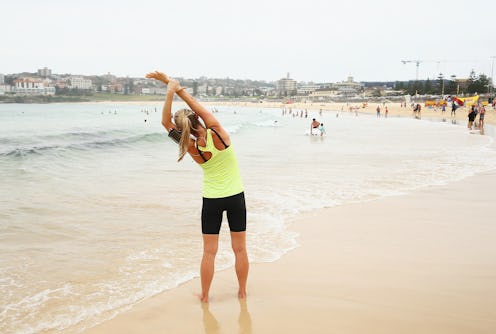So you've followed the rules of stretching and you've really been making an effort to make it a part of your daily routine, but you're still looking for ways to become more flexible. No reason to feel bad. Let's face it, not all of us were born with the spineless grace of Russian contortionist Julia Gunthel or "Zlata." (I searched "most flexible person in the world" and Gunthel quickly put my toe-touching pride to shame.) Stretching is incredibly important for a number of reasons, especially with improving flexibility and the range of motions in your joints, according to Mayo Clinic. But let's be honest here — sometimes we just don't have enough time to get around to it. That, or we easily give up on said stretch because we're just not flexible enough to do it properly.
Believe it or not, there are little things you can incorporate in your daily routine to become more flexible. Changes you make to the way you sit, stand, sleep, and just go about the general tasks of your day can totally make a difference. Here are some of the things to become a little more conscious of, as suggested by stretch coaches and dancers who share their flexibility habits.
1. Sitting
There are always ways to sneak in exercise at work. Even if you aren't sitting in an office chair and you're lounging around in front of the TV instead, there are certain positions you could try that will slowly help improve your flexibility. Strike a low-key yoga pose! When appropriate of course, try sit in straddle or lunge poses. Poses like lotus or full lotus position are also good options. If you can't really do these at your desk, try twisting your body at a 90 degree angle on each side. Want more examples? There are actually a lot of different desk stretches you can try to increase flexibility, according to the Mayo Clinic.
2. Sleep On Your Back
There's a great deal of controversy over the best way to sleep — with pillows, without pillows, on your back, stomach, side, or on a bed of roses — it really just comes down to the individual. YouTube fitness blogger Erica Lin noted sleeping without pillows as a way to increase flexibility without stretching. Lin explained that pillows won’t allow your neck and spine to decompress properly. Either way, sleeping in the supine position (on your back) — with or without pillows — does allow your spinal discs to open and expand when laying flat. As New York City chiropractor Steven Diamant explained to CNN Health, sleeping on your back makes it easy for your head, neck, and spine to maintain a neutral position. So when you do try some stretches in your waking hours, it’ll be easier and feel more natural, Lin added.
I can personally attest to this helping so much after breaking my back one summer. As someone who has been more of a stomach sleeper my entire life, I did notice more ease and less back pain in my movements when I switched to sleeping on my back.
3. Concentrate On Posture
Straighten it! According to the American Chiropractic Association, not only is maintaining good posture essential for your health, but it also correlates with better flexibility. By slouching, you restrict muscles in your lower back, shoulders, and neck. So it makes sense that by sitting up straight, you’re lengthening the disks in the spine and therefore allowing them to move more freely.
4. Exagerrate Everyday Movements
Remember that fitness blogger I mentioned earlier? Aside from her sleeping suggestion, Lin showed some neat little tricks in this video to sneak in that flexibility, some of which have already been mentioned. Here's where doing those little everyday things really comes into play. Cut back on the laziness by raising your phone when you text, for example. Or, stretch out your arms and raise your book at eye level for a little bit.
As LIVESTRONG contributor and health writer Chekwube Ndubisi (who has a doctoral degree in pathobiology and molecular medicine) explained, shoulder stretches and range-of-motion exercises are recommended to maintain strength and flexibility in the shoulders and upper arms. Try doing a set of shoulder shrugs or head and neck rolls when you can. Any time you're making movements, you're working towards loosening up those muscles.
5. Move While Standing
Let's continue with making more movements. To target flexibility in your legs, when standing around or waiting in line, Lin suggested trying butt crunches and calf raises. These are super subtle ways to get in those mini stretches by simply keeping those muscles engaged. It may make waiting in line at least a little more fun and interesting.
6. Take Bigger Strides
When taking the stairs, skip a few steps to really stretch out those legs too. Or even when you're walking, try taking giant steps every once in awhile to wake up your limbs a bit more and give them that nice stretch they've been craving.
7. Wear Comfortable Clothing
And to be able to make all these little things even easier, whenever you can, try wearing more comfortable clothing that doesn't restrict movement. There are so many cute ideas for exercise clothes that can be worn to work if you're living that nine to five office life.
Though you still may not be exactly at Olympic-level gymnast flexibility, if anything, these little tricks can help you get at least one step closer to your flexibility goals. Just by moving around more, you're going to be doing your body a huge favor. And who cares if you look silly doing it? Just rock it.
Images: Giphy (6)
